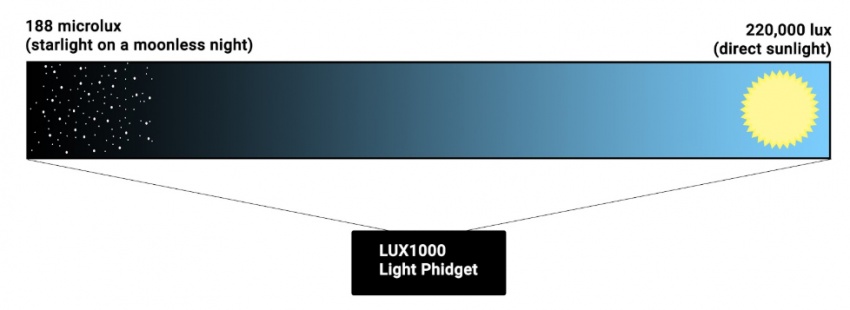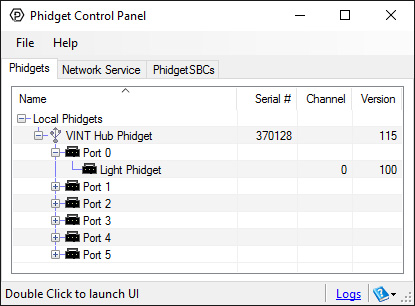LUX1000 - Product Video
Product video for the Light Phidget (LUX1000_0)

The LUX1000 measures brightness (illuminance). This Phidget is useful when creating automated systems that need to switch on/off at night or in low-light conditions. This Phidget connects to your computer through a VINT Hub.
This Phidget is a smart device that must be controlled by a VINT Hub. For more information about VINT, have a look at the VINT Overview page. You can use a Phidget Cable to simply and easily connect the two devices. Here's a list of all of the different VINT Hubs currently available:
| Product | Board Properties | |||
|---|---|---|---|---|
| Part Number | Price | Number of VINT Ports | VINT Communication Speed Max | Controlled By |
 VINT Hub Phidget
|
$40.00 | 6 | 1 Mbit/s | USB (Mini-USB) |
 1-Port VINT Hub Phidget
|
$24.00 | 1 | 1 Mbit/s | USB (USB-A) |
 VINT Hub Phidget
|
$35.00 | 6 | 1 Mbit/s | USB (Mini-USB) |
 VINT Hub Phidget
|
$30.00 | 6 | 100 kbit/s | USB (Mini-USB) |
 Wireless VINT Hub
|
$60.00 | 6 | 100 kbit/s | Local Network (Ethernet or Wi-Fi) |
 PhidgetSBC4
|
$120.00 | 6 | 100 kbit/s | — |
Use a Phidget cable to connect this device to the hub. You can solder multiple cables together in order to make even longer Phidget cables, but you should be aware of the effects of having long wires in your system.
| Product | Physical Properties | |
|---|---|---|
| Part Number | Price | Cable Length |
 Phidget Cable 10cm
|
$1.50 | 100 mm |
 Phidget Cable 30cm
|
$1.75 | 300 mm |
 Phidget Cable 60cm
|
$2.00 | 600 mm |
 Phidget Cable 60cm
|
$2.00 | 600 mm |
 Phidget Cable 90cm
|
$2.00 | 900 mm |
 Phidget Cable 120cm
|
$2.25 | 1.2 m |
 Phidget Cable 150cm
|
$2.50 | 1.5 m |
 Phidget Cable 180cm
|
$2.75 | 1.8 m |
 Phidget Cable 350cm
|
$3.00 | 3.5 m |
 Phidget Cable Kit
|
$10.00 | 80 mm |
 Phidget Cable Extension Wire 22AWG
|
$0.75/Meter | — |
The LUX1000 measures brightness (illuminance) from 188 microlux (starlight on a moonless night) to 220,000 lux (direct sunlight).

You can use your Control Panel to explore your Phidget's channels.
1. Open your Control Panel, and you will find the Light Phidget channel:

2. Double click on the channel to open an example program. This channel belongs to the Light Sensor channel class:
In your Control Panel, double click on "Light Phidget":

Before you open a Phidget channel in your program, you can set these properties to specify which channel to open. You can find this information through the Control Panel.
1. Open the Control Panel and double-click on the red map pin icon:

2. The Addressing Information window will open. Here you will find all the information you need to address your Phidget in your program.

See the Phidget22 API for your language to determine exact syntax for each property.
The Change Trigger is the minimum change in the sensor data needed to trigger a new data event.
The Data Interval is the time (in ms) between data events sent out from your Phidget.
The Data Rate is the reciprocal of Data Interval (measured in Hz), and setting it will set the reciprocal value for Data Interval and vice-versa.
You can modify one or both of these values to achieve different data outputs. You can learn more about these properties here.
Note: Graphing and logging is currently only supported in the Windows version of the Phidget Control Panel.
In the Phidget Control Panel, open the channel for your device and click on the ![]() icon next to the data type that you want to plot. This will open up a new window:
icon next to the data type that you want to plot. This will open up a new window:

If you need more complex functionality such as logging multiple sensors to the same sheet or performing calculations on the data, you'll need to write your own program. Generally this will involve addressing the correct channel, opening it, and then creating an Event Handler and adding graphing/logging code to it.
The quickest way to get started is to download some sample code for your desired programming language and then search google for logging or plotting in that language (e.g. "how to log to csv in python") and add the code to the existing change handler.
You can perform filtering on the raw data in order to reduce noise in your graph. For more information, see the Control Panel Graphing page.
You can perform a transform on the incoming data to get different graph types that may provide insights into your sensor data. For more information on how to use these graph types, see the Control Panel Graphing page.
Firmware Upgrade
MacOS users can upgrade device firmware by double-clicking the device row in the Phidget Control Panel.
Linux users can upgrade via the phidget22admin tool (see included readme for instructions).
Windows users can upgrade the firmware for this device using the Phidget Control Panel as shown below.

Firmware Downgrade
Firmware upgrades include important bug fixes and performance improvements, but there are some situations where you may want to revert to an old version of the firmware (for instance, when an application you're using is compiled using an older version of phidget22 that doesn't recognize the new firmware).
MacOS and Linux users can downgrade using the phidget22admin tool in the terminal (see included readme for instructions).
Windows users can downgrade directly from the Phidget Control Panel if they have driver version 1.9.20220112 or newer:

Firmware Version Numbering Schema
Phidgets device firmware is represented by a 3-digit number. For firmware patch notes, see the device history section on the Specifications tab on your device's product page.

The LUX1000 can measure the intensity of light in the range of 188µlx to 220klx. The device achieves this wide range due to its ability to dynamically change the gain value on its measurements, in addition to changing the amount of integration time taken per measurement. Changing the gain coarsely affects the range, while changing the integration time finely affects the range.
Because of these dynamic ranges, you may see momentary saturation when trying to measure large changes in light intensity in short periods of time (for example, a strobe light). Once the light level stabilizes, the sensor will settle back into optimal range settings.
The light sensor on the LUX1000 is designed to sense light in a way that emulates the response of the human eye. However, digital light sensors work very differently than our eyes do. Using the photoelectric effect, the photodiodes in the sensor will generate current when struck by incoming photons. The problem is that the range of wavelengths that these photodiodes respond to vary depending on what materials they are made of, and none of them have the same response as the human eye.
The solution, offered by the chip used in the LUX1000, is to take readings from two different photodiodes. One photodiode detects only IR light (light invisible to the human eye), and one photodiode detects both visible and IR light. The device weights the measurements with coefficients based on calibration testing. Then takes the difference between the IR component from the combined IR and visible light. The result is a workable approximation of brightness, as seen by a human eye.
| Sensor Properties | |
|---|---|
| Controlled By | VINT |
| Sensor Type | Light |
| VINT Communication Speed Max | 10 kbit/s |
| Light Sensor | |
| Light Level Min | 188 μlx |
| Light Level Max (5V) | 220 klx |
| Light Resolution | 188 μlx |
| Sampling Interval Min | 125 ms/sample |
| Sampling Interval Max | 60 s/sample |
| Electrical Properties | |
| Current Consumption Max | * 500 μA |
| Current Consumption Min | 20 μA |
| Physical Properties | |
| Operating Temperature Min | -15 °C |
| Operating Temperature Max | 70 °C |
| Customs Information | |
| Canadian HS Export Code | 9027.50.00 |
| American HTS Import Code | 9027.50.40.60 |
| Country of Origin | CN (China) |
* - Current consumption varies depending on selected data interval. See the graph below for details.

| Date | Board Revision | Device Version | Comment |
|---|---|---|---|
| June 2017 | 0 | 100 | Product Release |
| March 2022 | 0 | 101 | A reading of 0 lux no longer fires a saturation error |
| Channel Name | API | Channel |
|---|---|---|
| Light Sensor | LightSensor | 0 |
| Product | Sensor Properties | Light Sensor | |||
|---|---|---|---|---|---|
| Part Number | Price | Sensor Type | Controlled By | Light Level Min | Light Level Max (5V) |
 Light Phidget
|
$12.00 | Light | VINT | 188 μlx | 220 klx |
 Light Sensor 1000 lux
|
$7.00 | Light | Voltage Input (0-5V) | 1 lx | 1 klx |
 Light Sensor 70000 lux
|
$7.00 | Light | Voltage Input (0-5V) | 3 lx | 70 klx |